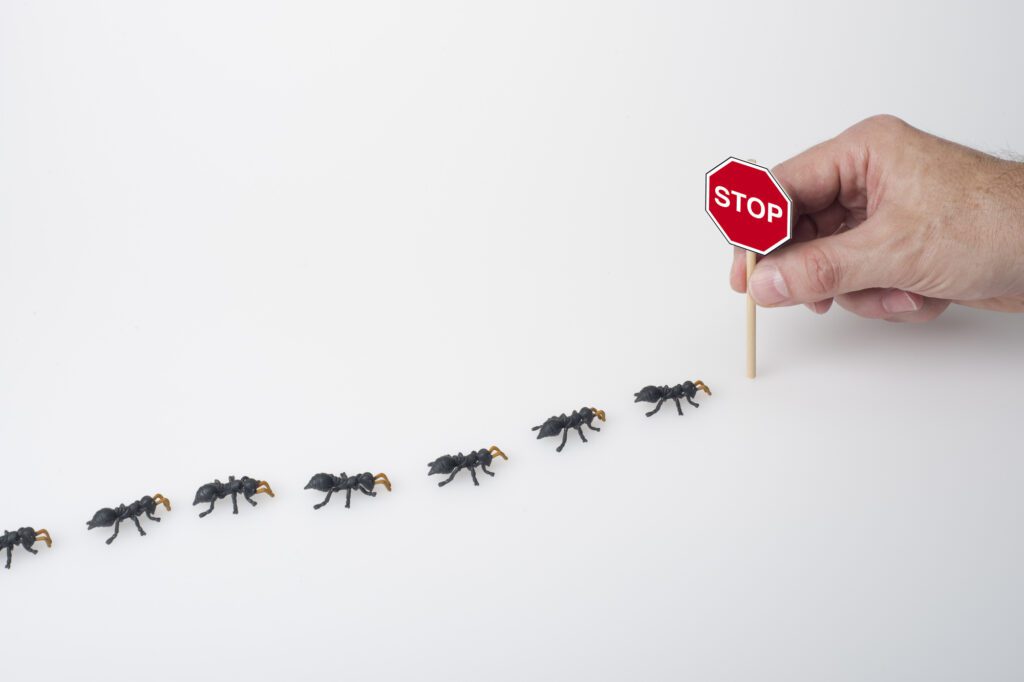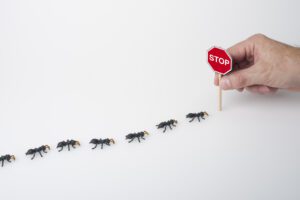
We'll Take Care of Any Ants You Encounter
Call us at (517) 999-5008 and we will provide you with a free over-the-phone quote. Wolverine Pest Services is a family-owned pest control company that serves Grand Rapids and the surrounding areas of SE Michigan. We are a Faith-Based, Veteran-Family-Owned Company & a trusted BBB Accredited business that has been working hard for our customers and in business since 2008. We provide ant removal and pest control services to residential, commercial, and industrial clients near Grand Rapids with dozens of 5-star Reviews on Home Advisor & positive Google Reviews. We are proud to serve the greater Grand Rapids, MI, surrounding areas and offer a satisfaction guarantee on all our exterminator, ant removal, and pest control services.
Get Rid of Persistent Ants
Call for a FREE quote over the phone! (517) 999-5008
So, How Are Ants Detected?

Ants can be detected in a variety of ways, including visual observation, trapping and baiting, and chemical detection. Visual observation can involve looking for ants or using flashlights and magnifying glasses. Trapping and baiting can include setting up ant traps and baits to lure ants into a specific location where they can be observed. Chemical detection involves applying a chemical solution to an area where ants are present and then looking for signs of ant activity.
How Do You Keep Ants Away
To keep ants away, try using natural deterrents such as cinnamon, coffee grounds, vinegar, peppermint oil, cucumber peels, and lemon peels. You can also use commercial ant baits or sprays. Additionally, it helps to keep the area clean and free of food debris and crumbs.

Common Types of Ants Found in Michigan?
The most common types of ants in Michigan include the pavement ant, odorous house ant, carpenter ant, and yellow crazy ant. Other species that may be encountered in the state include the Argentine ant, thief ant, bigheaded ant, and European fire ant.
Pavement ants
The pavement ant (Tetrasodium caespitum) is a small ant native to Europe that has become established in North America. It is a nuisance pest around homes and buildings, as it nests in pavement, between stones, and even within walls. They are also known to invade homes in search of food. The workers are about 2.5–3 mm long and dark brown. They have a pair of spines on the back of their thorax and a single node between their thorax and abdomen.
Odorous house ants
The odorous house ant (Tapinoma sessile) has a distinct smell when crushed, described as smelling like coconut or rotten coconut, rotten onions, or blue cheese.
Carpenter ants
Carpenter ants are a species of ants that can be found in Grand Rapids homes and are known for their wood-eating habits. They are typically black and can range from 1/4 to 1/2 inch in length. They are found primarily in the United States and Canada but can be found in other areas of the world as well. They typically feed on dead trees and decaying wood but will also feed on living trees as well. They can cause serious damage to structures if left unchecked, as they can hollow out wood for nesting and tunneling.
Yellow crazy ants
Crazy ants, also known as Raspberry ants or yellow crazy ants, are an invasive species of ants native to tropical and subtropical regions of Asia and Africa. They were first found in the United States in 2002 and have since spread to many areas of the southern United States, including Texas, Florida, and Hawaii. They are known for their rapid reproduction rate, aggressive behavior, and their ability to form massive colonies. These ants are considered a major pest and can cause significant damage to crops, plants, and the native ecosystems they invade. Control methods for crazy ants include baiting and trapping, as well as the use of pesticides for Grand Rapids properties in SE Michigan.
Argentine ants
Argentine ants (Linepithema humile) are an invasive species of ants that can sometimes be found in Grand Rapids homes and are native to South America and have spread around the world. They are a major agricultural pest, as well as a nuisance in homes and gardens. Argentine ants are known for their large colonies and aggressive behavior, which allow them to outcompete native species of ants. They feed on a wide variety of food sources, including nectar, honeydew, and other insects, and are notorious for their habit of building “super colonies” that link multiple nests together. Control of Argentine ants relies on a combination of chemical and non-chemical methods, including baiting, habitat modification, and exclusion.
Thief ants
The thief ant is a species of ant that is native to tropical regions, including parts of the United States, such as Grand Rapids, MI, and even Mexico, Central America, and the Caribbean. The species is known to live in large colonies with hundreds of thousands of workers. The thief ant is a small species of ant, measuring only 1.5 to 2 mm in length. It is yellow to brownish and has a slender body and long antennae. The ant is known for its habit of stealing food from other ant colonies by entering their nests, hence the name. The thief ant feeds on other insects and dead insects, as well as sugary foods. They are also known to feed on the larvae of other ant species.
Bigheaded ants
Bigheaded ants (Pheidole megacephala) are a species of ant native to tropical regions of the world. They are called “big-headed” because of their enlarged head, which is used to store food. Bigheaded ants are nuisance pests, as they can invade homes and yards in search of food and nesting sites. They can also damage plant roots and cause allergic reactions in some people. To control big-headed ants, it is important to identify their nesting sites and remove them with insecticides.
European fire ants
European fire ants (Myrtice rubra) are a species of ant native to Europe. They are a pest species sometimes found in Grand Rapids, and they can form large colonies and can be quite aggressive. They have also been known to damage crops and invade buildings. European fire ants are also known to spread disease and are capable of stinging humans if they are disturbed.
Call For Ant Control
The most effective way to control ants is to use a combination of chemical and non-chemical methods. Chemical control involves using insecticides that are formulated specifically to target and kill ants. These insecticides can be applied directly to the nest or sprayed around the perimeter of the home. Non-chemical control includes eliminating food sources, sealing cracks and crevices that ants may use to enter the home, and removing ant trails with a mixture of vinegar and water. Additionally, ant baits can be used to attract and kill ants.
OTHER PEST CONTROL SERVICES IN GRAND RAPIDS
For all your service needs - Wolverine Pest Control today!
We are your Wolverine Pest Control company. Contact us today to rid your Grand Rapids home of unwanted ants! Whether you’re interested in Weekly, Monthly, Quarterly, or One-time pest control service visits…we have a program just for you! Keeping your time in mind…
